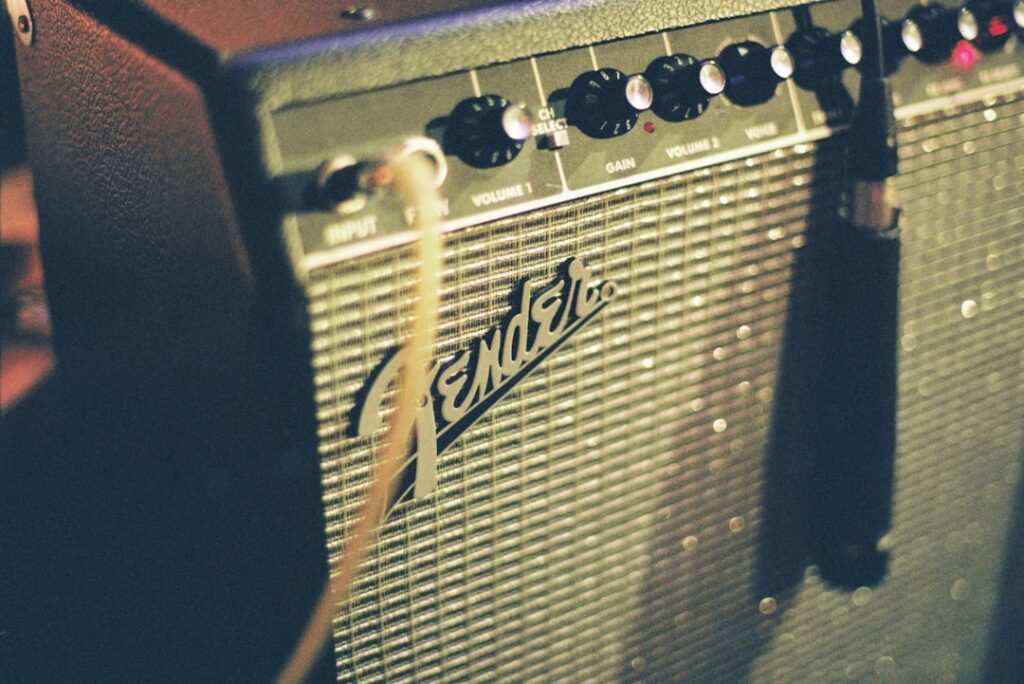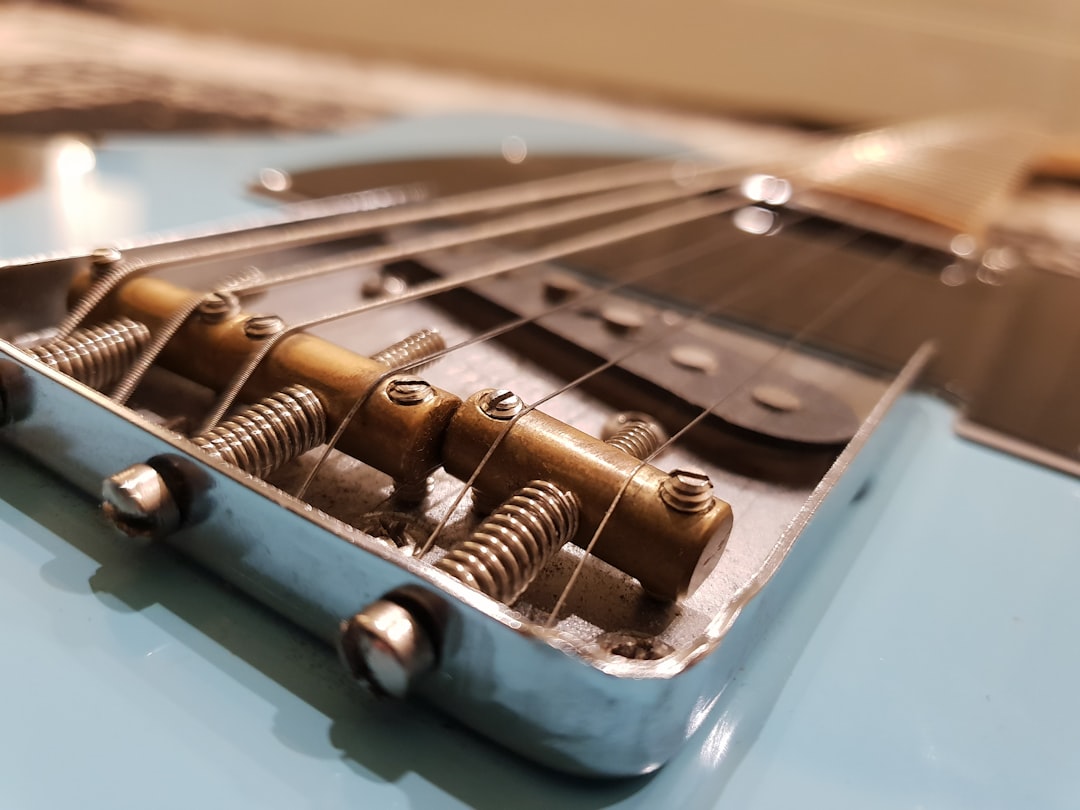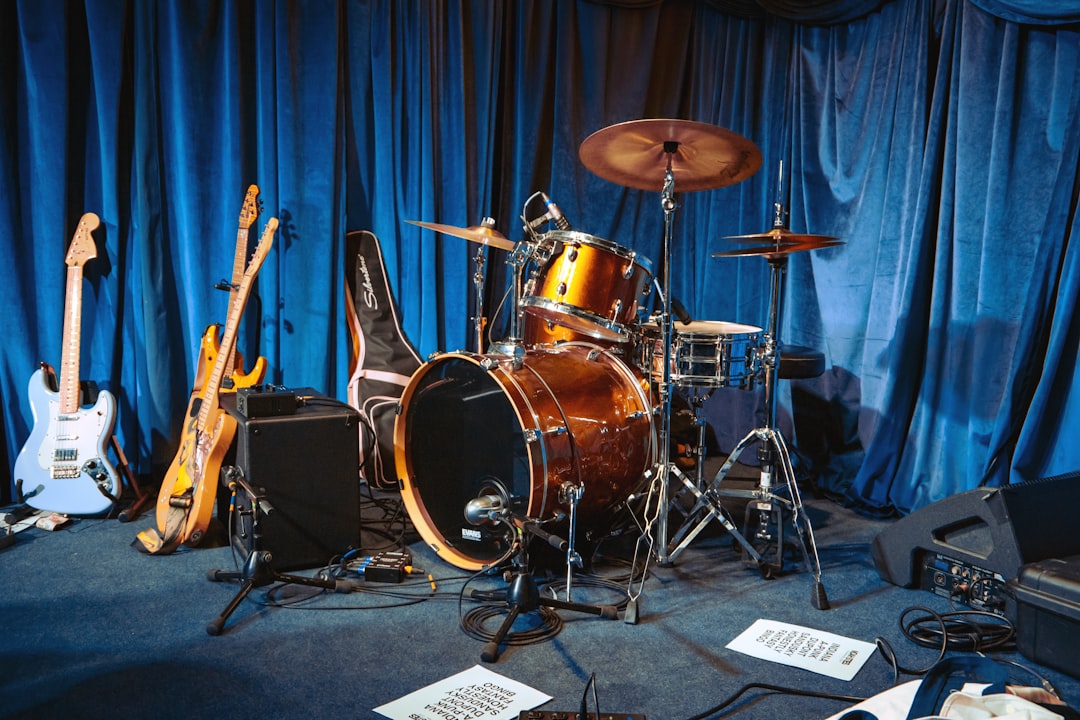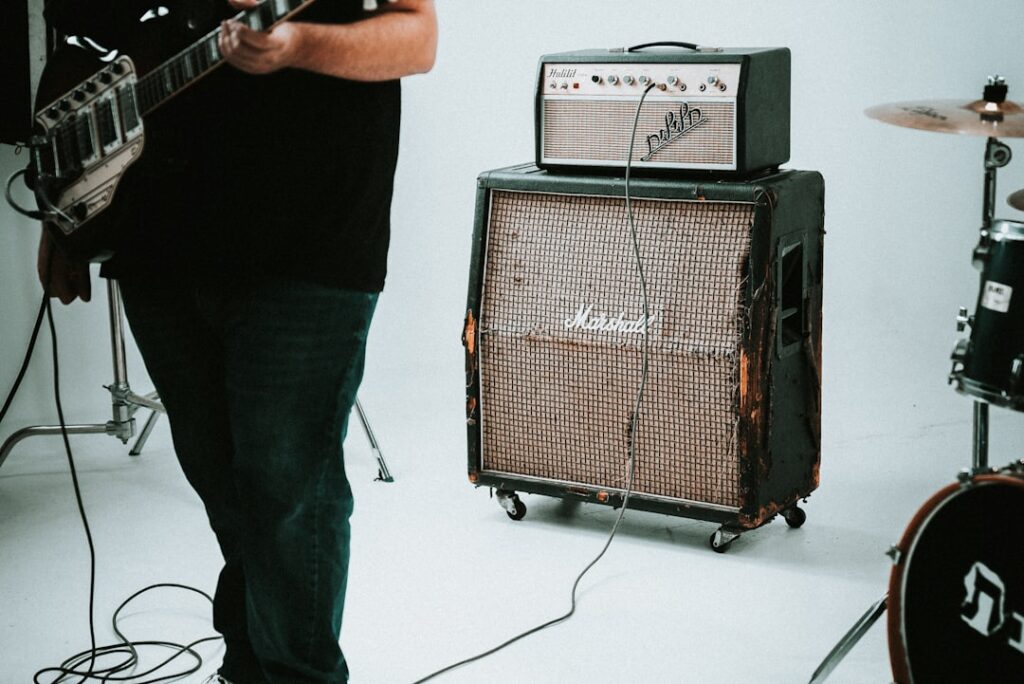- Introduction: The Sonic Vision of SUGIZO
- SUGIZO’s Amplifier Setup: Tone by Function
- SUGIZO’s Guitars: An Orchestra of Expression
- Effects & Pedalboard Architecture: SUGIZO’s Sonic Laboratory
- Sound Design Philosophy: EQ, Layers, and Spatial Engineering
- Affordable Alternatives: Reaching for the SUGIZO Sound on a Budget
- Conclusion: More Than Just Gear—A Sonic Philosophy
Introduction: The Sonic Vision of SUGIZO
SUGIZO, guitarist of the legendary Japanese rock band LUNA SEA, is much more than a guitar player—he is a sonic architect. His artistry stretches far beyond traditional rock guitar, incorporating electric violin, complex effects layering, ambient textures, and even political and philosophical elements. His soundscape is not just heard; it’s experienced.
Known for his ethereal use of delay and reverb, SUGIZO’s playing often creates vast, cinematic soundscapes. Whether it’s the soaring textures in LUNA SEA tracks like “I for You,” “STORM,” and “ROSIER,” his tones always serve the emotional core of the music, enhancing both its atmosphere and depth.
His setup is a hybrid marvel—vintage guitars like the Gibson ES-330 or ES-175 are paired with cutting-edge digital processing, ensuring both warmth and precision. Each guitar is purpose-built for specific songs, and his amps and pedalboards are modularly deployed based on the tone required.
In addition to guitars, SUGIZO integrates unique instruments like a triple-neck guitar and a custom 5-string electric violin into his setup, seamlessly blending them into his performance. Truly, he is a guitarist who “visualizes sound.”
This article provides a detailed breakdown of his amps, guitars, effects, and mixing strategies. If you’re looking to emulate the expansive and expressive sound of LUNA SEA, this guide will give you a solid foundation.
▶ Search LUNA SEA official YouTube videos
SUGIZO’s Amplifier Setup: Tone by Function

SUGIZO’s amplifier configuration is anything but conventional. Rather than just using amps by gain stages—clean, crunch, lead—he splits his rig by sonic function. Some amps handle delay returns, others are tuned for rhythm guitar tonal color, and some serve solo sections with extra sustain and clarity.
The EVH 5150III is his main high-gain powerhouse, delivering aggressive yet articulate distortion. To support and thicken chords, he complements it with the Divided by 13 LDW 17/39, which provides tighter low-end and a robust midrange, resulting in a fuller tone when layered.
For solos, he often uses the BOGNER ECSTASY, known for its silky sustain and sensitivity to picking dynamics. For rhythm sections, the DIEZEL VH-4 offers quick-response distortion and mid-low focus, ensuring the guitar holds space within the band’s dense ensemble.
The Marshall JVM410H, custom-modded by Commune to feature a Super Resonance circuit, brings out low-end definition for stage use. Meanwhile, the Fender Tonemaster, although not used conventionally, acts as a speaker extension within his system rather than a standalone amp.
Also essential is the VHT Two/Fifty/Two Power Amp Black Beauty, used exclusively to amplify delay-processed signals. In tandem with the Fractal Audio AXE-FX III, it provides pristine, immersive ambient layers via separate cabs, enhancing clarity in live environments.
Ultimately, SUGIZO’s amp setup reflects a mixer’s mindset—each unit is selected for its role in constructing a multidimensional sonic experience. This thoughtful segmentation is a pillar of LUNA SEA’s iconic sound.
| Gear | Brand | Amazon Link | Artist | Guitarist | Notes |
|---|---|---|---|---|---|
| 5150III | EVH | Amazon Search | LUNA SEA | SUGIZO | Main high-gain distortion amp |
| LDW 17/39 | Divided by 13 | Amazon Search | LUNA SEA | SUGIZO | Blended with 5150III to add harmonic depth |
| ECSTASY | BOGNER | Amazon Search | LUNA SEA | SUGIZO | Smooth sustain for lead parts |
| VH-4 | DIEZEL | Amazon Search | LUNA SEA | SUGIZO | Rhythm amp with fast, focused distortion |
| JVM410H (Commune mod) | Marshall | Amazon Search | LUNA SEA | SUGIZO | Custom-modded for deep low-end clarity |
| Tonemaster | Fender | Amazon Search | LUNA SEA | SUGIZO | Used as a system-integrated speaker cab |
| Two/Fifty/Two Power Amp | VHT | Amazon Search | LUNA SEA | SUGIZO | Dedicated power amp for ambient/delay processing |
SUGIZO’s Guitars: An Orchestra of Expression

SUGIZO’s guitar collection is as vast and eclectic as his music. From vintage hollow-bodies to custom-designed signature models, his instruments are carefully selected to enhance specific sonic landscapes in both live and studio contexts. It’s not unusual for him to switch guitars multiple times within a single performance, choosing each one for its tonal character.
Among the most iconic are his vintage models—such as the 1961 Gibson ES-330TD with P-90 pickups, which produces a warm, rounded tone perfect for down-tuned tracks like “KAMOGAWA” and “Rebellmusik.” The 1963 ES-175, with its jazz-influenced tone, is used in half-step-down tunings for ballads like “MEGUROGAWA” and “Love Is Everywhere.”
His signature Navigator N-ST SGZ Custom line includes the -DII-, frequently seen in songs like “FATIMA” and “THE CAGE” in standard tuning, and the -EDEN-, a special edition created for charity and often used in mellow passages. A natural-finish variant, the -FZ-, is also prepared as a backup.
ESP’s ECLIPSE series is central to his modern setup, especially the S-Ⅷ BRILLIANT-MIXEDMEDIA, equipped with Seymour Duncan Antiquity II “Surfer” and Lollar P-90 pickups. It has become a visual and sonic centerpiece of his 2022 live gear. The aggressive V-Ⅷ variant supports heavier material like “FACE TO FACE” and other high-energy LUNA SEA tracks.
SUGIZO also utilizes an extraordinary ESP PR-TRIPLE NECK, featuring 12-string, fretless, and Floyd Rose-equipped 6-string necks. This guitar is a showstopper in performances of “LOVELESS” and “GENESIS OF MIND.”
His connection with Japanese guitarist Masami Tsuchiya is reflected in the Fender Stratocaster 60s “KIKUMARU,” which was gifted to him and used in songs like “gravity.” Inspired by this guitar, the Navigator N-ST-300 KIKUMARU Custom has been heavily featured in hits like “STORM,” “DESIRE,” and “I for You.”
For 12-string textures, he uses the Rickenbacker 360/12 (1964) in tracks like “MOTHER.” Meanwhile, for acoustic performances, the Gibson J-160E (1969) stands out—a nod to John Lennon’s iconic tone—used in songs such as “BREATHE.”
| Model | Brand | Amazon Link | Artist | Guitarist | Type | Usage Notes |
|---|---|---|---|---|---|---|
| ES-330TD 1961 | Gibson | Amazon Search | LUNA SEA | SUGIZO | Hollow-body (P-90) | Used for down-tuned songs like “KAMOGAWA” |
| ES-175 1963 | Gibson | Amazon Search | LUNA SEA | SUGIZO | Jazz archtop | Used in mellow half-step-down pieces |
| N-ST SGZ Custom -DII- | Navigator | Amazon Search | LUNA SEA | SUGIZO | Strat-type | Standard tuning; songs like “FATIMA” |
| N-ST SGZ Custom -EDEN- | Navigator | Amazon Search | LUNA SEA | SUGIZO | Strat-type (Charity Model) | Used in “Love Is Everywhere” |
| ECLIPSE S-Ⅷ | ESP | Amazon Search | LUNA SEA | SUGIZO | Strat-style hybrid | 2022 main guitar, mixed media finish |
| PR-TRIPLE NECK | ESP | Amazon Search | LUNA SEA | SUGIZO | 12+Fretless+6-string | Used in “GENESIS OF MIND” |
| Stratocaster “KIKUMARU” | Fender | Amazon Search | LUNA SEA | SUGIZO | Component ST | Gifted by Masami Tsuchiya; used in “gravity” |
| N-ST-300 KIKUMARU Custom | Navigator | Amazon Search | LUNA SEA | SUGIZO | Strat-type | Main for “STORM”, “DESIRE” |
| 360/12 1964 | Rickenbacker | Amazon Search | LUNA SEA | SUGIZO | 12-string | Used in the song “MOTHER” |
| J-160E 1969 | Gibson | Amazon Search | LUNA SEA | SUGIZO | Electro-acoustic | Used in acoustic sets like “BREATHE” |
Effects & Pedalboard Architecture: SUGIZO’s Sonic Laboratory
SUGIZO’s effect system is nothing short of extraordinary—an expansive, modular setup that resembles a sonic laboratory more than a conventional pedalboard. His rig is divided into multiple segments: on-stage pedalboards, rack-mounted processors, and systems controlled by his guitar tech. Each is tailored for a specific purpose, with the Fractal Audio AXE-FX III serving as the digital command center.
The AXE-FX III combines amp modeling, cab simulation, and high-quality multi-effects in one flagship unit. It’s the brain of SUGIZO’s digital arsenal, handling spatial effects while integrating seamlessly with external pedals and amps.
In the rack section, you’ll find powerful outboard gear like the API 3124MV (mic preamp/mixer), Sherman Filterbank 2 (analog filter), Jim Dunlop Crybaby Rack DCR-1SR, Eventide Eclipse (harmonizer), and the legendary TC2290 delay from tc electronic. Routing, gain staging, and mixing are handled by Free The Tone gear, enabling precise and complex stage-ready configurations.
On the stage, multiple pedalboards are deployed—some for violin, others for guitar, and even dedicated control boards. The violin board includes tools like the Strymon Big Sky (reverb), Timeline (delay), Eventide H9 (multi-effects), and FISHMAN Aura Spectrum DI for acoustic preamp functionality. These enable lush, spatially rich soundscapes tailored to the electric violin’s frequency range.
The guitar board leans more aggressive. BOSS RE-20 Space Echo provides analog-style echo textures; Maxon PDM1 brings modulation delay; Devi Ever: FX Shoegazer introduces noisy distortion tones; and the Providence Stampede OD handles overdrive duties. Together, they deliver punch, chaos, and color when needed.
Exclusive pedals like the Free The Tone RM-1S (ring modulator) and the Mazzy Fuzzy 2-in-1 (a collaboration between Masami Tsuchiya and Endroll) exemplify SUGIZO’s desire to craft sounds beyond the boundaries of traditional guitar work. These generate surreal textures crucial to his ambient and experimental tones.
Live expression is equally important. Pedals like the VOX V845 wah, Free The Tone DVL-1L volume pedal, and Source Audio Zio (buffer/boost) offer real-time dynamic control. Meanwhile, the guitar tech operates effects such as the Digitech Whammy DT, Eventide Time Factor, and iSP Decimator to further sculpt the live experience behind the scenes.
SUGIZO’s pedal system isn’t merely a collection of effects—it’s a design tool used to shape the acoustic and emotional space of every song. His approach redefines how effects integrate into the storytelling of live music.
| Effect | Brand | Amazon Link | Artist | Guitarist | Type | Usage Notes |
|---|---|---|---|---|---|---|
| AXE-FX III | Fractal Audio | Amazon Search | LUNA SEA | SUGIZO | Multi-FX/Modeler | Core of his sound architecture |
| RM-1S | Free The Tone | Amazon Search | LUNA SEA | SUGIZO | Ring Modulator | Signature model, used for alien-like tones |
| Big Sky | Strymon | Amazon Search | LUNA SEA | SUGIZO | Reverb | For both guitar and violin, lush spatial depth |
| RE-20 Space Echo | BOSS | Amazon Search | LUNA SEA | SUGIZO | Delay/Echo | Retro tape-echo feel; stage-mounted |
| Shoegazer | Devi Ever: FX | Amazon Search | LUNA SEA | SUGIZO | Distortion | Noisy textures for contrast and drama |
| Stampede OD | Providence | Amazon Search | LUNA SEA | SUGIZO | Overdrive | Center pedalboard, main gain booster |
| V845 Wah | VOX | Amazon Search | LUNA SEA | SUGIZO | Wah | Used on stage for real-time phrasing |
| Polytune | tc electronic | Amazon Search | LUNA SEA | SUGIZO | Tuner | Violin pedalboard component |
| Aura Spectrum DI | FISHMAN | Amazon Search | LUNA SEA | SUGIZO | DI/Preamp | Used for electric violin signal shaping |
| Time Factor | Eventide | Amazon Search | LUNA SEA | SUGIZO | Delay | Operated by tech; complex ambient layering |
Sound Design Philosophy: EQ, Layers, and Spatial Engineering

For SUGIZO, sound design isn’t just about achieving a “good guitar tone”—it’s about sculpting a physical space through sound. His role in LUNA SEA is often compared to a sonic architect, shaping the emotional and atmospheric dimensions of a song through intricate layering, effects, and EQ strategies.
His core distortion tone typically begins with the EVH 5150III—a powerful high-gain amp. However, he blends this with the Divided by 13 LDW 17/39 to add clarity and harmonic strength to chords. The LDW’s tight low-end and rich midrange create a fuller, more dimensional tone that maintains clarity in dense mixes.
For lead tones, the BOGNER ECSTASY is favored for its compressed yet fluid character. It responds precisely to picking dynamics, making it ideal for expressive solo work or as a counterpoint to fuzz-driven textures. A likely EQ setting here includes a slightly boosted Presence, Treble around 6.5–7.0, Mid around 5.5–6.0, and Bass slightly reduced around 4.5 to prevent boominess.
Beyond the amp EQ, SUGIZO leverages the Fractal Audio AXE-FX III’s internal parametric and graphic EQs to fine-tune frequencies that amps alone can’t address. Frequencies around 2–3kHz are often adjusted for presence and articulation—especially in live venues, where PA coordination plays a critical role in tonal adjustments.
His spatial effects are a standout component of his sound. Delays are stacked and layered using TC2290, Eventide Time Factor, and various AXE-FX III algorithms. Depending on the song, he may use multi-tap, reverse, or filter-infused delay types. For instance, in “STORM,” his delay preset likely includes BPM-synced quarter-note delay with diffusion for a lush trailing effect.
Reverb duties are handled primarily by the Strymon Big Sky, utilizing Hall or Cloud algorithms with noticeable pre-delay settings. This gives his playing space to breathe without muddying the mix. Eventide H9 adds harmonic depth through pitch-shifting effects like Crystals and Harmonizer, expanding the harmonic space in stereo.
SUGIZO also integrates experimental tools like ring modulators and analog filterbanks. Moogerfooger MF-102 and his signature Free The Tone RM-1S are featured prominently in ambient or noise-centric pieces like “RA-SE-N” or “Pray for Mother Earth.” These aren’t just effects—they are compositional elements that define the sonic world of a track.
On the mixing side, his spatial effects are routed through the VHT Two/Fifty/Two power amp into dedicated speaker cabs. This separation ensures delay and reverb do not smear the core tone, achieving both presence and depth. It’s a hybrid approach that merges the precision of a mixing engineer with the immediacy of a live guitarist.
Signal clarity is preserved through the use of ultra-high-fidelity buffers like the Source Audio ZIO and Free The Tone’s custom junction boxes. Even with dozens of pedals and layers of routing, SUGIZO maintains pristine signal integrity—something critical for dynamic live performances.
In essence, SUGIZO’s sound isn’t just about gear—it’s a philosophy. Every EQ tweak, routing path, or delay tap is part of a deliberate design to build an emotional and spatial experience. His guitar becomes a vessel, not just for melodies, but for atmosphere, storytelling, and vision.
Affordable Alternatives: Reaching for the SUGIZO Sound on a Budget
SUGIZO’s gear setup is famously complex and expensive—custom-built rigs, vintage guitars, boutique effects, and high-end rack systems. But that doesn’t mean recreating his signature tones is impossible without a five-figure investment. Here are cost-effective gear choices that can help intermediate players approach the LUNA SEA sound palette without breaking the bank.
For high-gain distortion, the BOSS MT-2W Metal Zone Waza Craft is a surprisingly viable substitute for the EVH 5150III. It offers a wide midrange EQ scope and delivers sharp, articulate distortion—perfect for those “scooped yet punchy” rhythm tones that define tracks like “ROSIER.” Its onboard EQ allows for flexible tone-shaping across different song types.
In the ambient department, the NUX Atlantic reverb/delay combo unit delivers outstanding value. It features dual-function ambient processing, enabling simultaneous Hall reverb and analog-style delay—a combination that works great for lush songs like “I for You” or “STORM.” It even supports BPM sync, a must-have for time-based precision in live sets.
If you want one all-in-one ambient pedal, the Zoom MS-70CDR is a compact powerhouse. It includes reverb, delay, chorus, and modulation—ideal for experimenting with complex spatial effects. With editable presets and deep parameter access, it offers shockingly pro-level results in a pedal costing under $100 USD.
To experiment with fuzz and sustain, go for the classic Electro-Harmonix Big Muff Pi. While not identical to SUGIZO’s signature Mazzy Fuzzy pedal, it delivers the same gritty sustain and bold tonality for soaring leads or noisy textures.
For modulation and character shaping, the BOSS CH-1 Super Chorus adds stereo width and warmth to clean tones—perfect for the kind of atmospheric layering SUGIZO often employs in his clean intros and bridges.
If you want to dive into multi-effects and IR-based processing, the Hotone Ampero Mini or Mooer P1 Prime Preamps offer a flexible and affordable way to emulate AXE-FX-like tones. While not on the same level as SUGIZO’s studio rig, these can serve as a mobile, low-cost launchpad for building diverse patches.
For wah and expressive control, the Jim Dunlop GCB95 Cry Baby is a great alternative to the VOX V845. It offers familiar tactile response, rugged build, and works well with both fuzz and delay-heavy tones typical in SUGIZO’s setup.
On the power and cabling front, while Free The Tone units are top-tier, more affordable options like the CAJ DC-DC Station II or One Control power supplies provide clean and stable power with minimal noise—crucial for multi-pedal boards running delays and modulation.
| Type | Model | Brand | Amazon Link | Inspired By | Use Case |
|---|---|---|---|---|---|
| Distortion | MT-2W Metal Zone Waza Craft | BOSS | Amazon Search | EVH 5150III | High-gain tone with detailed mid-sculpting |
| Ambient Multi-FX | Atlantic | NUX | Amazon Search | Big Sky + TC2290 | Hall reverb + delay in one pedal; BPM sync ready |
| All-in-One Modulation | MS-70CDR | Zoom | Amazon Search | AXE-FX ambience | Budget-friendly ambient textures |
| Fuzz | Big Muff Pi | Electro-Harmonix | Amazon Search | Mazzy Fuzzy | Lead sustain & noisy textures |
| Wah Pedal | GCB95 Cry Baby | Jim Dunlop | Amazon Search | VOX V845 | Live expressive control |
| Multi-Effects + IR | Ampero Mini | Hotone | Amazon Search | AXE-FX III | Compact modeling platform |
| Chorus | CH-1 Super Chorus | BOSS | Amazon Search | SUGIZO cleans | Stereo clean tones and ambient shimmer |
Conclusion: More Than Just Gear—A Sonic Philosophy

SUGIZO’s sound is not merely a collection of tones—it’s a fusion of emotion, space, and ideology. He isn’t just a technically skilled guitarist. He’s a storyteller who uses sound as his primary language. Through his expressive layering, ambient textures, and thoughtful integration of analog and digital gear, he invites listeners into a deeply immersive musical world.
What sets his rig apart isn’t just the quality of the equipment—it’s the intention behind every component. His entire live setup is treated like a carefully crafted acoustic ecosystem. From amp selection and pedalboard layouts to signal routing and FOH coordination, every detail is designed to serve a greater artistic narrative.
SUGIZO’s blend of vintage character and modern flexibility—embodied in guitars like the Navigator SGZ series or ESP triple-neck monsters—demonstrates his commitment to shaping tone in service of vision. The gear isn’t the goal; it’s the vessel.
And yet, as SUGIZO himself once said, “If you have delay and distortion, you can cover LUNA SEA.” This mindset speaks volumes. You don’t need boutique equipment to begin. What truly matters is understanding the role of each effect, how tones interact, and how dynamics convey emotion. With just a few well-chosen tools and a clear sonic intention, you can start walking your own path toward expressive, SUGIZO-inspired tone.
Experimenting with the affordable alternatives presented earlier can not only bring you closer to that sound but also nurture your growth as a guitarist. In chasing the essence of SUGIZO’s tone, you’ll refine your ear, deepen your musical sensitivity, and evolve your performance style.
Ultimately, the vast universe of SUGIZO’s sound is not just about musical gear—it’s about crafting a form of prayer, cosmos, and philosophy through tone. You can’t simply mimic it; you must feel it, design it, and make it your own. His approach is not just technical. It’s spiritual—and stepping into that world is one of the most rewarding journeys a guitarist can take.







コメント